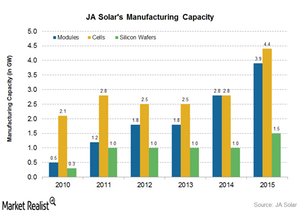A Look at JA Solar’s Business Strategy
JA Solar’s (JASO) future success largely depends on the ability to expand its manufacturing capacity and output.
Sept. 30 2016, Published 1:59 p.m. ET

Capacity expansion
As we’ve already seen, JA Solar (JASO) began its journey in the solar industry as a solar (TAN) cell manufacturer. However, the company diversified its business into silicon wafers, solar PV (photovoltaic) module production, and downstream project development. Currently, JASO derives the majority of its revenue from PV module sales. Its future success largely depends on the ability to expand its manufacturing capacity and output.
According to the company’s latest 20-F filing, its modules, solar cells, and silicon wafer manufacturing capacities were 3.9 GW (gigawatts), 4.4 GW, and 1.5 GW, respectively, at the end of fiscal 2015. Except for 2012, the company’s module manufacturing capacity has consistently been on the rise since 2010. According to company filings, JASO retired some of its outdated production lines of solar cells and solar modules in 2012.
Vertical integration
As part of its business strategy, JA Solar entered the downstream solar power project business in 2013. It did this to leverage its expertise in capturing the cost benefits associated at every stage of the PV product value chain.
JA Solar competes with Trina Solar (TSL), Yingli Solar (YGE), Canadian Solar (CSIQ), First Solar (FSLR), SunEdison (SUNEQ), and SunPower (SPWR) in the downstream solar business.
JA Solar’s module efficiency
JA Solar continues to invest in R&D (research and development) to develop more efficient, low-cost, and reliable solar modules. Any increase in module conversion efficiency will decrease the cost of raw materials used in module manufacturing.
In 2015, the company announced a new efficiency record of 20.9% for its Percium series modules. It reported an average conversion efficiency of its mainstream monocrystalline and multicrystalline solar cells at 19.7% and 18.5%, respectively.
In the next part of this series, we’ll look at JA Solar’s downstream project pipeline.
